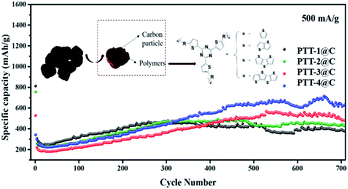The polymers based on thiophene armed triazine and different thiophene derivatives including thiophene (Th), thieno[3,2-b]thiophene (TT), dithieno[3,2-b:2′,3′-d]thiophene (DTT) or thieno[2′,3':4,5]thieno[3,2-b]thieno[2,3-d]thiophene (TTTT) are synthesized through a Stille coupling reaction. By introducing thiophene derivatives with increasing sizes as the linkage units (from thiophene, DT to DTT, TTTT), the band gaps (Eg) of the resultant polymers decrease continuously. Then the composite materials (polymer@C) between polymers and Vulcan XC-72 carbon are prepared by in situ polymerization to test their electrochemical performances in lithium ion batteries. The synthesized composites show distinct morphologies due to the different linkage units of thiophene or fused cyclothiophene derivatives and the cross-linked structure can be found in composites with the longer thiophene derivatives (bridging molecules) like PTT-3@C and PTT-4@C, which are expected to be beneficial to improve the performances of the electrode materials. The specific capacities of the composites are 495 mA h g−1, 671 mA h g−1, 707 mA h g−1, and 772 mA h g−1 for PTT-1@C, PTT-2@C, PTT-3@C and PTT-4@C at a current density of 100 mA g−1, respectively. In particular, benefiting from the enlarged conjugation length and planarity of the linkage units, the conjugated microporous polymers could deliver continuously improved capacities.

